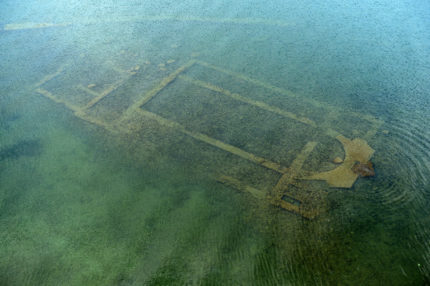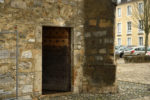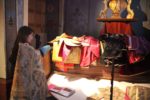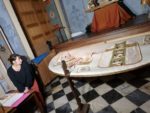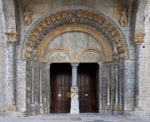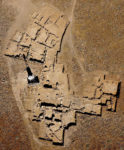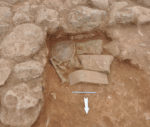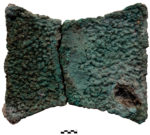 A 15,000-year-old mammoth hunting trap has been discovered in Tultepec, a town 25 miles north of Mexico City. This is first discovery of a deliberate trap set by humans to capture mammoths (as opposed to natural traps like swamps which humans also took advantage of) and judging by the number of bones found, it was a raging success. In nine months of excavations, archaeologists from Mexico’s National Institute of Anthropology and History (INAH) have recovered 824 bones from 14 of the Pleistocene giants.
A 15,000-year-old mammoth hunting trap has been discovered in Tultepec, a town 25 miles north of Mexico City. This is first discovery of a deliberate trap set by humans to capture mammoths (as opposed to natural traps like swamps which humans also took advantage of) and judging by the number of bones found, it was a raging success. In nine months of excavations, archaeologists from Mexico’s National Institute of Anthropology and History (INAH) have recovered 824 bones from 14 of the Pleistocene giants.
A very rare almost complete skeleton of a Columbian mammoth was discovered by accident during sewer construction in another neighborhood of Tultepec in December 2015, so when INAH was alerted that crews working on the municipal landfill had found massive bones on January 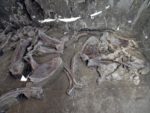 29th of this year, archaeologists were deployed to excavate the remains. The context of the 2015 discovery indicated the mammoth met its end at human hands after getting stuck in the mud. The bones were mostly disarticulated, with only the largest (skull, pelvis) found in the proper anatomical relationship to each other, suggesting the animal was butchered. The newly-discovered mammoth bones were also disarticulated, but in a marked difference from the previous find, the excavation revealed vertical cuts in the
29th of this year, archaeologists were deployed to excavate the remains. The context of the 2015 discovery indicated the mammoth met its end at human hands after getting stuck in the mud. The bones were mostly disarticulated, with only the largest (skull, pelvis) found in the proper anatomical relationship to each other, suggesting the animal was butchered. The newly-discovered mammoth bones were also disarticulated, but in a marked difference from the previous find, the excavation revealed vertical cuts in the 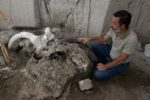 archaeological layers. The cuts formed two trenches five and a half feet deep and more than 80 feet in diameter. The walls go straight down at an almost 90 degree angle. Stratigraphic analysis dates these pits to 14,700 years ago, thanks to the tell-tale five inches of ash from the eruption of the Popocatepetl volcano that took place then.
archaeological layers. The cuts formed two trenches five and a half feet deep and more than 80 feet in diameter. The walls go straight down at an almost 90 degree angle. Stratigraphic analysis dates these pits to 14,700 years ago, thanks to the tell-tale five inches of ash from the eruption of the Popocatepetl volcano that took place then.
Archaeologists also discovered the molar of a horse, the mandible and two vertebrae of a camel, but there’s no evidence those animals were hunted. The size of the pits and the huge number of mammoth bones found inside them make it clear that these traps were meant specifically to catch 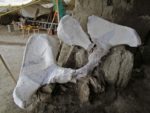 mammoth. INAH archaeologist Luis Córdoba Barradas believes the two pits were not isolated, but part of a line of traps that would allow hunters to maximum their results and minimize labour. Chasing megafauna into a trap is risky, exhausting business. With a series of traps, they didn’t have to pull all their mammoths in one basket, so to speak. Should one change direction at the last minute away from the trap, the hunting party could try again directing it to the next one.
mammoth. INAH archaeologist Luis Córdoba Barradas believes the two pits were not isolated, but part of a line of traps that would allow hunters to maximum their results and minimize labour. Chasing megafauna into a trap is risky, exhausting business. With a series of traps, they didn’t have to pull all their mammoths in one basket, so to speak. Should one change direction at the last minute away from the trap, the hunting party could try again directing it to the next one.
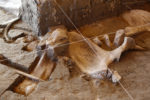 The bone evidence confirms this was an organized, thorough system that made the most of every catch. The ribs were used as cutting tools to butcher the animals, an ulna believed to have removed subcutaneous fat. The skulls are often found upside down, an indication that the community ate the animals’ brains, and a hefty meal they would have made at up to 25 pounds a pop.
The bone evidence confirms this was an organized, thorough system that made the most of every catch. The ribs were used as cutting tools to butcher the animals, an ulna believed to have removed subcutaneous fat. The skulls are often found upside down, an indication that the community ate the animals’ brains, and a hefty meal they would have made at up to 25 pounds a pop.
There is also evidence of ritual or at least reverent treatment of the remains. One specimen, of which two-thirds of the bones have been unearthed, was arranged in an unusual configuration: his scapulae stacked and placed on the left side of the skull, a dorsal vertebra between the tusks, and embracing this tableau the 10-foot-long curved tusk of another mammoth. The bones of this individual bear a mark from a previous attack and the left tusk is shorter than the right because it broke and regrew. This suggests the hunters had knew of this one particular mammoth, had battled him before and perhaps positioned his remains as a means of paying their respects.
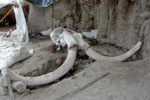 The skeletal remains of the 14 mammoths found at the site will be transported to the Museum of the Mammoth in Tultepec where the one excavated in 2016 is currently on display. Mineralized bones can be surprisingly delicate, so they will have to be carefully conserved and stabilized before going on display.
The skeletal remains of the 14 mammoths found at the site will be transported to the Museum of the Mammoth in Tultepec where the one excavated in 2016 is currently on display. Mineralized bones can be surprisingly delicate, so they will have to be carefully conserved and stabilized before going on display.
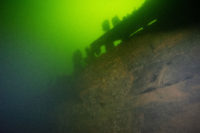 Two wrecks of 17th century warships, one of them believed to be the sister ship of King Gustav II Adolf’s flagship Vasa which famously sank less than a mile from the dock on its maiden voyage on August 10th, 1628, have been discovered in the Swedish archipelago in a strait outside the town of Vaxholm.
Two wrecks of 17th century warships, one of them believed to be the sister ship of King Gustav II Adolf’s flagship Vasa which famously sank less than a mile from the dock on its maiden voyage on August 10th, 1628, have been discovered in the Swedish archipelago in a strait outside the town of Vaxholm.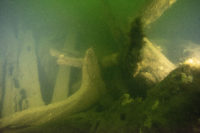 The wrecks are in good condition, preserved in the cold, brackish waters of Lake Mälaren. Not the kind of condition the Vasa is in, salvaged from Stockholm bay in 1961, but that’s to be expected because unlike their ill-fated cousin, these ships actually served in Sweden’s navy, fought battles, and were deliberately scuttled at the end of their topside lifespan to serve in their watery graves as defensive spike strips to damage any enemy ships seeking to attack Stockholm through the straight.
The wrecks are in good condition, preserved in the cold, brackish waters of Lake Mälaren. Not the kind of condition the Vasa is in, salvaged from Stockholm bay in 1961, but that’s to be expected because unlike their ill-fated cousin, these ships actually served in Sweden’s navy, fought battles, and were deliberately scuttled at the end of their topside lifespan to serve in their watery graves as defensive spike strips to damage any enemy ships seeking to attack Stockholm through the straight.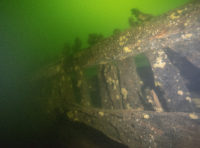 Henrik Hybertsson, the Dutch master shipwright who made the Vasa at the Stockholm navy yard, was commissioned to build four ships in total, two larger ones with 135-foot keels (Vasa and Äpplet) and two smaller ones (Kronan and Scepter) with 108-foot keels. Archaeologists think one of the two newly-discovered wrecks may be Äpplet as it appears to match Vasa in design and size. It was laid down in 1627 and launched in 1629.
Henrik Hybertsson, the Dutch master shipwright who made the Vasa at the Stockholm navy yard, was commissioned to build four ships in total, two larger ones with 135-foot keels (Vasa and Äpplet) and two smaller ones (Kronan and Scepter) with 108-foot keels. Archaeologists think one of the two newly-discovered wrecks may be Äpplet as it appears to match Vasa in design and size. It was laid down in 1627 and launched in 1629.The divers took wood samples of the ships which will be sent to a laboratory for dating.
